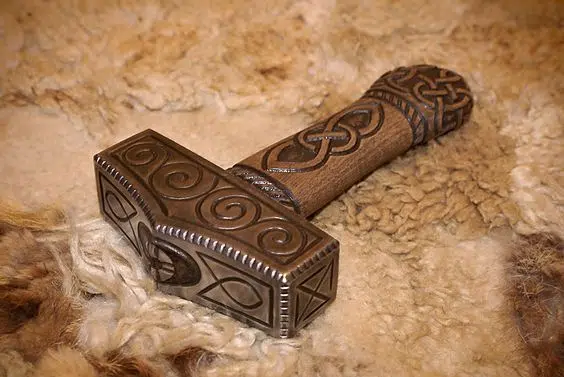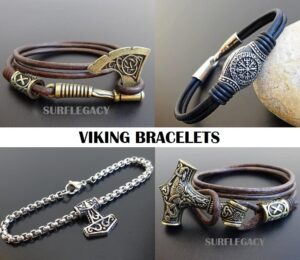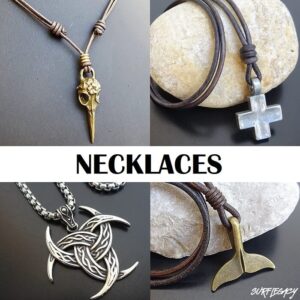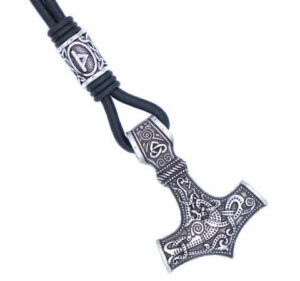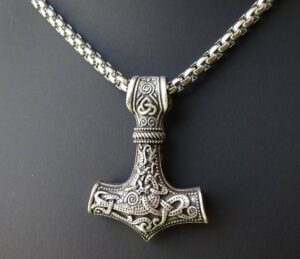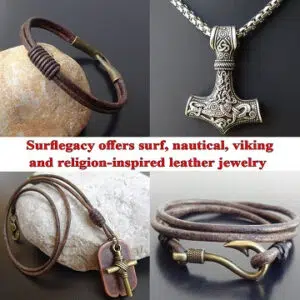Weapons always played an important role in Norse Mythology. In this article, we will discuss the 10 best Legendary Norse Mythology Weapons mentioned in the Norse Sagas. For ease of use, we have listed the weapons in alphabetical order.
1 Angurvadal sword of Frithiof
Another magical sword was Angurvadal, which meant “stream of anguish” in old Norse. It was inscribed with Runic letters that blazed in times of war but only gleamed dimly in times of peace, according to Norse mythology.
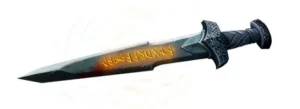
Angurvadal was owned by the Norse hero Frithiof, son of the hero Thorstein Vikingsson, according to Norse Mythology.
The sons of King Beli of Sign, the king of the Norwegian region, were envious of Frithiof, who was said to be the tallest, strongest, and bravest of men. They prevented Frithiof from marrying their foster sister Ingeborg out of jealousy.
They sent Frithiof on a mission to Orkney, burned down his homestead, and married Ingeborg to the elderly King Ring while he was gone. Frithiof, who has nothing, sets sail with Viking warriors to make his fortune.
He returns a number of years later and visits King Ring, with whom he becomes friendly. After the elderly king dies, he appoints Frithiof as earl of his kingdom, and Frithiof is soon able to marry his true love Ingeborg and become the king’s true heir.
He takes advantage of his newfound power to declare war on the Norwegian brothers and exact his revenge.
2 Dainslief
Dainsleif was one of the most powerful weapons in Norse Mythology. Although its reputation paled in comparison to the Tyrfing sword, its power was no joke.
Dainsleif belonged to king Högni, a legendary king in Viking mythology, according to Snorri Sturluson (Icelandic author of the Prose Edda).
The dwarf Dain, one of the universe’s most famous and talented craftsmen, created the Dainsleif sword. The term “Dainsleif” referred to Dain’s legacy.
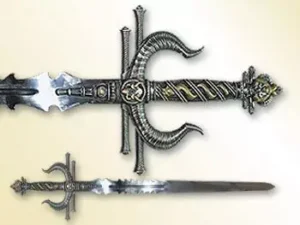
According to legend, once this Dainsleif was drawn from its sheath, someone had to die to quench the sword’s blood thirst.
When it reveals its blade, the holder must use it to behead someone. Dainsleif’s magical sword, like the Gungnir spear, never missed its mark.
Prose Edda mentions the famous sword. It told the story of King Hogni, his lovely daughter Hild, and the kings’ eternal battle. In the story, Hogni came to meet with other kings, and he brought his daughter with him.
Unfortunately, Hedin Hjarrandason, another king who attended the meeting, kidnapped his lovely daughter.
When Hogni found out what had happened, Hedin had brought Hild with him on his journey. The king father immediately summoned his warriors to rescue his beloved daughter.
First, his men informed him that Hedin had gone north. As King Hogni approached the north, he saw no sign of his daughter and was told that Hedin had gone west with a beautiful woman.
Then, in pursuit of his daughter, King Hogni turned his ship west.
When the King finally met his daughter on an island, Hild expressed her desire for his father to make peace with Hedin, who had kidnapped her. However, King Hogni declined the proposal.
He stated unequivocally that he intended to wage war on those who had duped him into capturing his beloved daughter. The two parties then prepared to go to war with one another.
King Hogni declared that it was too late to stop the war. Someone had to die to quench his thirst for blood because he had drawn his Dainsleif sword. If this sword were to injure someone, the wound would never heal.
The battle began with a spear being thrown, and the two kings fought day and night. Many warriors were killed, but the battle showed no signs of abating. When night fell, both sides’ warriors retreated to their ships.
Only Hild, Hogni’s daughter, remained on the battlefield. Using her magic, she began to resurrect the fallen warriors.
The kings continued to fight the next day, and the warriors continued to include those who had died the previous days. This became a never-ending loop.
According to some sources, this battle lasted 143 years, rather than forever.
This type of revival was common in Norse mythology, as the Einherjar warriors who shared Valhalla with Odin fought each other on a daily basis.
When night fell, their wounds began to heal, and they would feast, chant, and be entertained in the Great Hall Valhalla alongside their gods. And the next morning, their health was restored to excellent condition, and they continued fighting as they had the day before.
3 Gram
A magical sword first used by the hero Sigmund in the Scandinavian ‘Poetic (or Elder) Edda,’ ‘Prose (or Younger) Edda,’ and ‘Volsunga Saga.’ Sigmund was able to free the sword from the Branstock tree, where it had been placed by the god Odin himself.
Odin declared that whoever could remove the sword would be its rightful owner, and that the sword would always triumph.
The sword was rewelded by Regin and used by Sigmund’s son Sigurd (Siegfried) to slay the dragon Fafnir, Regin’s brother who held the Nibelungs’ treasure.
Sigurd then used the sword to kill Regin, who had been plotting to kill Sigurd after he had used the hero to kill the dragon for him.
Regin was a master craftsman and Sigurd’s foster father, according to the ‘Prose Edda.’ Regin forged Gram, which was so sharp that when Sigurd dropped it in running water, it slashed a tuft of wool that drifted with the current against the sword’s edge in half. Sigurd then used the sword to split Regin’s anvil down to its base.
Siegfried’s sword is known as Balmung in the Germanic epic ‘Song of the Nibelungs.’
It is stolen by his murderer, Hagen, and later used to slay Hagen by Siegfried’s widow Kriemhild. The sword is called Notung in Wagner’s operatic ‘Ring’ cycle, and it is reforged by Siegfried himself after his foster father, the scheming dwarf Mime, is unable to repair it.
Siegfried then uses it to kill the dragon Fafnir and obtain the treasure, which includes the cursed Nibelungs ring.
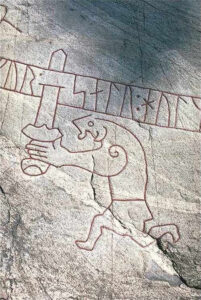
A depiction of Sigurd with Gram on the Ramsund carving, dated to around the year 1030
4 Gungnir
Is the name of the god Odin’s mighty spear. Gungnir is the weapon most regularly and powerfully linked with Odin in the recorded Norse tales. Poetry and visual art both demonstrate how deep and long-lasting this connection is.
Odin was referred to as Gungnis váfar (“Gungnir’s shaker”) as early as the ninth century by the poet Bragi Boddason.
Odin is frequently depicted in pre-Christian Scandinavian visual art with a spear; in fact, the spear is one of his most common iconographic attributes.
As one would expect from a god’s weapon, Gungnir is no ordinary spear. It was made by the dwarves, the most skilled smiths in the universe, according to the story of how the gods’ greatest treasures were made.
Gungnir is said to have runes carved on its point, which presumably increase its aim and deadliness via magic.
The spear is said to be so well balanced that no matter how skilled the wielder, it never misses its target. According to Norse mythology, this is the spear that Odin will wield during the great battle of Ragnarok, the end of the world.
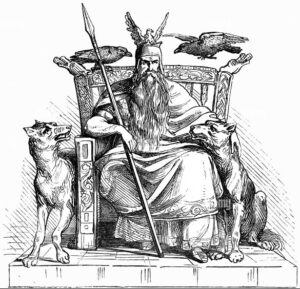
Odin poses with his two wolves, Geri and Freki, the two ravens, Huginn and Muninn, and his spear Gungnir.
Archaeology confirms that the Norse and other Germanic peoples did carve runes into some of their spears, possibly in imitation of Gungnir’s mythical model. Other aspects of Gungnir undoubtedly served as mythical models for human behavior. This is especially true when it comes to the spear’s role in human sacrifices to Odin.
Spears and axes were the most common weapons used by Viking warriors, so it’s no surprise that the Viking god of war’s main weapon was a spear.
Odin is described in Norse mythology as throwing his spear over the heads of the Vanir gods, the other race of gods in Norse mythology, prior to a mighty battle between the Aesir and Vanir gods.
He started the battle by hurling his spear over the enemy army and shouting, “inn á yr alla!” (“Odin owns you all!”) The historical Norse repeated this paradigmatic gesture, presenting the opposing army to Odin as a gift in the hope that the god would reciprocate by granting them victory.
Similarly, when Odin sacrificed himself to find the runes, he simultaneously stabbed himself with Gungnir and hanged himself.
It’s fitting, then, that when the Norse sacrificed someone to Odin, whether a single person or a large group of people, they usually did so with a spear, either alone or in conjunction with hanging.
5 Hofund sword of Heimdall
Heimdallr’s sword. Gylfaginning chapter 26 mentions it. Heimdall, Old Norse Heimdallr, the gods’ watchman in Norse mythology.
Heimdall, the shining god and the whitest-skinned of the gods, lived at Asgard’s entrance, guarding Bifrost, the rainbow bridge.
He slept less than a bird, could see 100 leagues, and could hear grass growing in the meadows and sheep wool growing.
Gjallarhorn, the “ringing” horn that could be heard throughout heaven, earth, and the lower world, was kept by Heimdall; it was believed that he would sound the horn to summon the gods when their enemies, the giants, drew near at Ragnarök, the end of the world of gods and men.
When that time came, Heimdall and his adversary Loki would be killed. Vikings enthusiasts also believed that Heimdall used his magical sword to defeat Loki in the battle of Ragnarok.
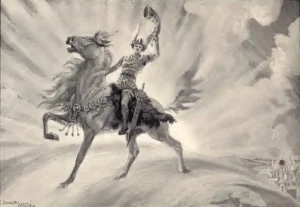
Heimdall on his horse the horn and his sword
6 Laevateinn
Loki, the trickster god of Norse mythology, forged the mythological weapon Laevateinn. The weapon, however, is shrouded in mystery, which seems appropriate given that it was created by the trickster Loky.
The weapon is mentioned in the Poetic Edda poem Fjölsvinnsmál. The name Lævateinn does not appear in the original manuscript reading, but is an emendation made by Sophus Bugge and others from Hævateinn.
Various commentators and translators have claimed that Laevateinn is a dart (or other projectile weapon), a sword, or a wand. Several sources gloss it as literally meaning a “wand” that causes damage, but some of the same sources also claim that the name is a kenning for sword.
Others think of it as a magic wand (seiðr staff). According to Fiölsvith “the very wise” porter in the poem Fjölsvinnsmál, Laevateinn is the only weapon capable of defeating the cockerel Viofnir.
The weapon is required to slay the rooster Viofnir who sits atop the world tree Mmameir in order for the seeker to complete his quest, according to the poem’s title character, the wise porter Fjölsvir.
7 Mjolnir
Mjolnir, the hammer of Thor, the Norse god of thunder and fertility, is another weapon fashioned by the dwarfs of Norse mythology. Mjolnir means “grinder” or “crusher” in old Norse.
It is one of the most terrifying weapons in Norse mythology, capable of leveling mountains.
Another mythical weapon was obtained by Loki from the dwarves.
Loki, the trickster (see also Loki Mythology) was in a particularly naughty mood one day and chopped off the beautiful golden hair of Sif, Thor’s wife.
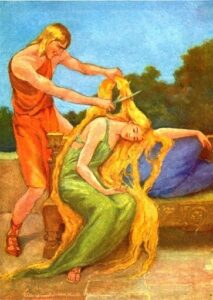
1930 Katharine Pyle Loki cuts Sif’s Hair
Thor’s quick temper was outraged when he learned of this, and he grabbed Loki and threatened to break every bone in his body.
Loki begged Thor to let him go down to Svartalfheim, the dwarves’ enormous dwelling, to see whether those great crafters could construct Sif a new head of hair that was even more magnificent than the original.
Thor agreed, and Loki set sail towards Svartalfheim.
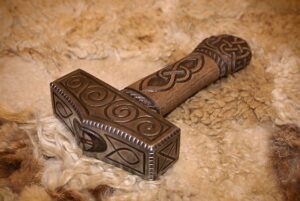
He was able to get what he wanted there. The dwarf Ivaldi’s sons created not just a new head of hair for Sif, but also two additional marvels: Skidbladnir (“Assembled from Thin Pieces of Wood”), the best of all ships that can be folded up and carried in one’s pocket, and Gungnir (“Swaying”), the deadliest of all spears.
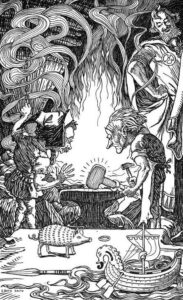
After completing his mission, Loki was overcome by the desire to remain in the dwarves’ caves and indulge in even more recklessness.
He approached the brothers Brokkr and Sindri and taunted them, saying he was certain the brothers could never forge three new creations equal to those fashioned by the sons of Ivaldi. In fact, he bet his head on their incompetence.
Brokkr and Sindri, on the other hand, accepted the wager. A fly, who, of course, was Loki in disguise, stung Sindri’s hand as they worked. It was a living boar with golden hair that the dwarf pulled from the fire.
Gullinbursti (“Golden-bristled”) was a horse that could run faster than any other horse, even through water or air. Sindri then set fire to another piece of gold while Brokkr worked the bellows.
The fly, Draupnir, bit Brokkr on the neck, and Sindri drew out a magnificent ring. Every ninth night, eight new golden rings of equal weight fall from this ring. Sindri then put iron on the hearth and told Brokkr that they needed to be extra careful with this next project because a mistake would be more costly than the previous two.
Loki stung Brokkr’s eyelid immediately, and the blood clogged the dwarf’s eye, preventing him from seeing his work properly.
Sindri made an unrivaled hammer that never missed its target and would boomerang back to its owner after being thrown, but it had one flaw: the handle was too short.
Sindri lamented that this had nearly ruined the piece, Mjolnir. Nonetheless, certain of the great value of their three treasures, Sindri and Brokkr traveled to Asgard to claim their wages.
Loki arrived at the halls of the gods before the dwarves and presented the wonders he had gathered. Thor received Sif’s new hair as well as the Mjolnir hammer. The ring Draupnir and the spear Gungnir were given to Odin.
And Freyr was delighted to receive Skidbladnir and Gullinbursti. As grateful as the gods were to receive these gifts, particularly Mjollnir, which they anticipated would be invaluable in their battles against the giants, they concluded that Loki still owed the dwarves his head.
When the dwarves approached Loki with knives, the cunning god reminded them that he had promised their heads but not their necks. Brokkr and Sindri returned to their forge, content with sewing Loki’s mouth shut.
Thor’s hammer had various meanings because he was both the god of thunder and fertility.
It was, of course, a powerful warrior’s weapon, wielded by Thor to fight giants, but it was also used to bless weddings, births, and funerals and often worn as a pendant by Vikings for protection
8 Skofnung
In Norse Mythology, any weapon possessed a magical power associated with gods, heroes, and legends.
The Skofnung sword, which was regarded as the best sword ever carried in Northern lands, was one of the weapons. According to the Sagas, the Skofnung sword was the sharpest and strongest sword ever created.
It was said to have belonged to Hrólf Kraki, a legendary Danish king. However, whether King Kraki was a real person or not remained unknown.
The sword was discovered inside a burial mound attributed to King Kraki, according to scholars. The origin of the sword, however, remained unknown due to a scarcity of reliable sources.
It was said to be supernaturally sharp and hard, and to be infused with the spirits of the king’s twelve faithful berserker bodyguards.
According to the sagas (Eid of Ás in chapter 57 of the Laxdœla) the sword must never be drawn in the presence of women, and the sun must never shine on the sword’s hilt. It is also said that unless rubbed with the Skofnung stone, a Skofnung wound will never heal.
The king was thought to have been buried with the sword, as was common Viking practice, but the sword was stolen from his burial mound by the Icelandic warrior Skeggi of Midfirth, according to the sagas.
It was then passed down to his son Eid of As, who in turn passed it down to his cousin Thorkel Eyjolfsson.
Thorkel dies in a shipwreck, and the sword becomes lodged in some of the ship’s timbers before washing ashore, where it is retrieved by Thorkel’s son Gellir, with whom the sword is said to have been buried (again).
9 The sword of Freyr
The sword of Freyr, a Norse god associated with sunshine, summer, and fair weather, is depicted in Norse mythology as one of the few weapons capable of fighting on its own.
Freyr will die at Ragnarök because he gave up the sword to Skrnir in exchange for the hand of the giantess Gerr. In the Prosa Edda, Frey requests that Skrnir bring Gerr to him, but his messenger demands his sword, which Frey readily gives.
The loss of Frey’s sword, on the other hand, has long-term consequences. Freyr had to fight Beli without his sword and slay him with an antler, according to the Prose Edda.
The outcome at Ragnarök, the end of the world, will be far more dire. Frey is fated to face the fire-giant Surtr, and he will be defeated because he lacks his sword. In the Poetic Edda, Surtr’s sword shines with the sun of warrior gods in Ragnarok.
One theory holds that the sword used by Surtr to slay Freyr is his own, which Freyr had previously bargained away for Gerr.
This would add another tragic layer to the myth. Sigurur Nordal argued in favor of this interpretation, but the possibility represented by Ursula Dronke’s translation that it is a simple coincidence is also viable.
The sword is given to Skrnir and used to threaten Gerr in the poem Skrnismál, but it is not explicitly given to the giantess, her father, or Surtr.
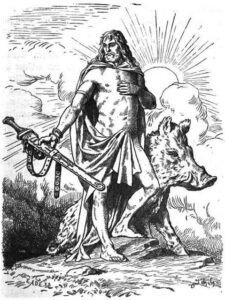
Freyr by Johannes Gehrts, shown with his sword
10 Tyrfingr sword
We come across the story of shieldmaiden Hervor, a young woman who always participated in battles, in the Hervarar saga, a legendary Norse saga from the 13th century containing traditions of wars between Goths and Huns, from the 4th century, and used as a source for Swedish medieval history.
Hervor wielded the magical sword Tyrfing. It was a fantastic weapon that rendered any warrior who used it invincible. Tyrfing, like the Sun, was always shining brightly, and every time its edge was exposed, someone was killed. Even the smallest wound caused by the sword would kill any living creature.
Svafrlami was Gararki’s king and Inn’s grandson. He was able to capture the dvergar Dvalinn and Durinn after they had left the rock where they lived. Then he forced them to forge a sword with a golden hilt that would never miss a stroke, never rust, and could cut through stone and iron as easily as clothes.
The sword was made by the dvergar, and it shone and gleamed like fire. However, in retaliation, they cursed it to kill a man every time it was drawn and to be the source of three great evils. Finally, they cursed it so that it would also kill Svafrlami.
When Svafrlami heard the curses, he attempted to kill Dvalinn, but the dvergr vanished into the rock, and the sword was driven deep into it, missing its intended victim.
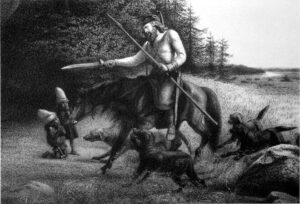
Svafrlami with his sword Tyrfing
Svafrlami was killed by the berserker Arngrmr, who then took the sword. It was worn by Angantr and his eleven brothers after Arngrmr.
They were all slain at Sams by the Swedish champion Hjálmarr and his Norwegian sworn brother rvar-ddr; but Hjálmarr, wounded by Tyrfingr (its first evil deed), has only time to sing his death-song before dying, and requests that rvar-ddr bring his body to his beloved Ingibjrg, daughter of Yngvi at Uppsalir.
Hervr Angantsdóttir (by his wife Tófa), Angantr’s daughter, was raised as a bond-servant and was unaware of her parentage.
When she found out, she armed herself as a shield-maiden and traveled to Munarvoe in Sams to retrieve her father’s weapon. She discovered it and married Hfundr, King Gumundr’s son.
They had two sons, Heirekr and Angantr, together. In secret, Hervr gave Heirekr the sword Tyrfingr. Heirekr showed Angantr the sword while they were walking.
The curse the dwarves had placed on the sword caused Heirekr to kill his brother Angantr after he had unsheathed it. Tyrfingr’s evil deed was the second of three.
Heirekr ascended to the throne of the Goths. Heirekr camped in the Carpathians during a voyage (Harvaa fjöllum, cf. Grimm’s law).
He was accompanied by eight mounted thralls, who eventually entered his tent and slew him in his sleep, the third and final evil deed of Tyrfingr. Heirekr’s son, Angantr, captured and killed the thralls and reclaimed the magical sword, thus ending the dwarves’ curse.
Angantr was the next Goth king, but his illegitimate half-Hun brother Hlr wanted a share of the throne. Gizurr called Hlr a bastard and his mother a slave-girl after Angantr refused.
The Goths were invaded by Hlr and 343,200 mounted Huns (See The Battle of the Goths and Huns). The Huns outnumbered the Goths by a large margin.
The Goths triumphed because Angantr used Tyrfingr to murder his brother Hlr on the battlefield. The numerous warriors’ bodies clogged the rivers, causing a flood that filled the valleys with dead men and horses.
Where to find the ideal Viking Jewelry
Finding the ideal Viking Jewelry can be challenging if you lack inspiration or don’t know where to look. Surflegacy, on the other hand, has you covered.
We have a wide range of Norse Jewelry in various styles, shapes, colors, and materials, to accentuate your Viking look. Our pieces are crafted in Italy with care, style in mind, and reasonably priced, so you won’t have to break the bank to get one. Visit our store and let us assist you on your fashion journey.

